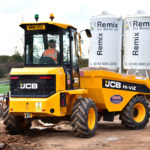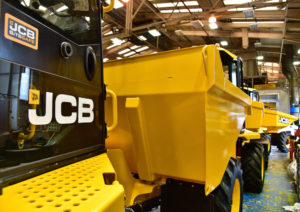 Construction Plant News tours the JCB Site Dumper production line at the company’s world headquarters
Construction Plant News tours the JCB Site Dumper production line at the company’s world headquarters
Whilst almost every class of construction plant has evolved and developed with the available technology, the site dumper has, until recently, remained a machine largely frozen in time. All around it site safety standards tightened, and concerns for operator welfare increased, but this humble muck shifting solution had hitherto continued to stubbornly occupy its own unchanging space, with a fundamental design that altered little in many decades. Thanks to the efforts of manufacturers like JCB, however, a new chapter is opening in the dumper story.
What precipitated this new approach was, of course, concerns over safety, which has led the 6 and 9 tonne units in the range to be equipped with cameras, but there is still simply no substitute for good old fashioned line of sight. A driver that can clearly see a worker at relatively close range, and who can acknowledge each other with the time-honoured thumbs up, is worth all the electronic wizardry in the world, and that’s the guiding principle of the 7-tonne Hi Viz concept, a machine with greatly increased levels of all-round visibility thanks to a significantly reduced skip height. In fact, even with a fully laden bucket, a 1.2 metre high person or object standing one metre from the machine is easily seen. Not only that, but a longer wheelbase and reduced centre of gravity will enhance stability, and reduce the incidence of tipping, even when traversing the most treacherous of ground conditions.
It’s not all about visibility, of course, because today’s construction industry rightly puts far greater emphasis on the welfare of its workforce. For the driver there simply isn’t a good time of year to be spending any length of time at the controls of the traditional class of site dumper. In the winter, wind and rain is the enemy, whilst the dust that the summer sun sends up brings little rest-bite, and that’s why the 6, 7, and 9 tonne units from the Staffordshire-based manufacturer can all be specified with cabs. “We’re definitely seeing a greater uptake on the cabbed models than we anticipated,” explains JCB’s General Manager – Site Dumpers, Leigh Harris. “We see the cab as very much the destiny of the dumper, which is why we’ve engineered our 6 and 9 tonne units so the ROPS bar can be removed and a cab easily retrofitted. If a customer doesn’t want to make that change now they can then do it relatively easily in the future.”
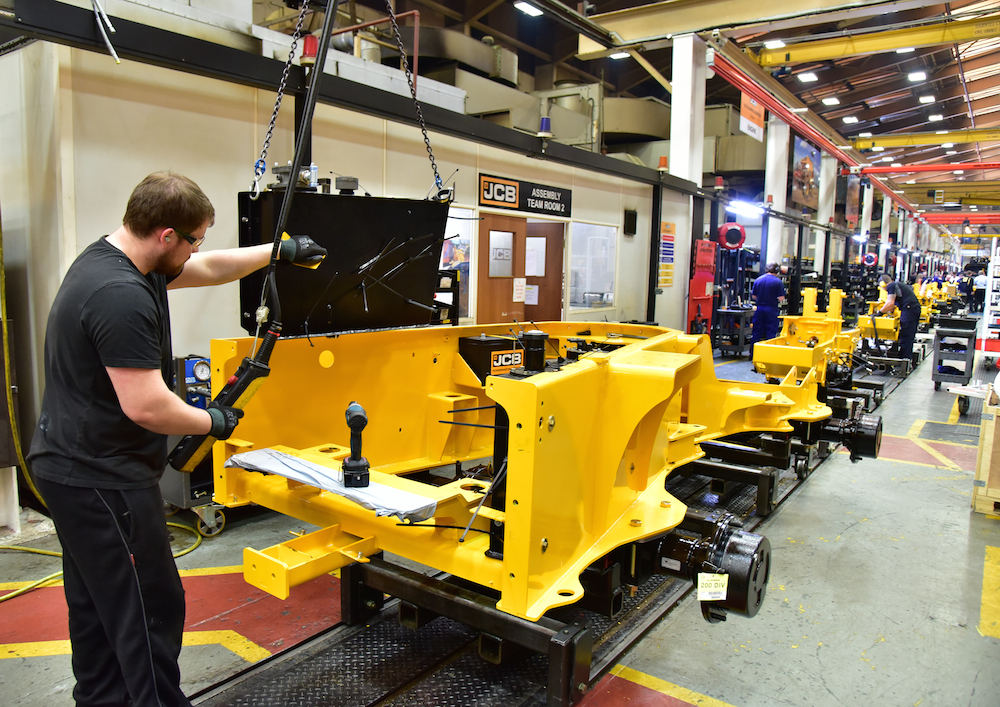
These new concepts are now in full production in a factory that has already been busy producing the iconic backhoe because, alongside that existing line at its World HQ, JCB is now manufacturing a full range of dumpers from 1 – 9 tonnes. Reassuringly for the customer the full weight of the company’s experience in making the backhoe has been applied to the dumper, with the same laser cutters, the same robot welders, and the same inspection process, all in evidence for both. Indeed, the axles, gearbox, transmissions and the 55kW, 75hp JCB EcoMax engine are shared by both backhoe and dumper alike. Not only does this make it easier for the Staffordshire factory to convert one of its existing lines to dumper manufacture it also provides dealers and end users with a common platform and one stop shop for two different classes of equipment – with the same oils and the same fast moving parts required to keep both machines types on the move.
The dumper range was subject to a three-year process of design, and that’s a level of detail much in evidence in the finished product. In an industry where residual value is king, particularly for hirers, durability is demanded as standard, and that’s why all of the models in the range have rejected plastic in favour of a metal construction. The machine is protected by a full steel surround, for example, with a recess between that surround and the cooling pack to ensure that any impact won’t result in damage to the radiator. Similarly, when the dumper is at work on site, and road lights are not required, these can be safely folded away and protected.
Safety is a recurring theme wherever you look on these site dumpers. That’s why a full width steel steering column protects the driver’s legs, whilst the hammer glass equipped cab has been tested with a 13 tonne excavator arm slewing into it at full speed. A brand new concept in the dumper sector is the introduction of a speedo, which will make it much easier for operators to adhere to site speed limits. Another perennial problem for site managers has been drivers not wearing seat belts, with the more canny employees simply buckling the belt and then sitting on it. In itself a machine with a cab will at least partially eliminate the problem because, if the site worker is safely ensconced in a ROPS/FOPS Level II and OPS cab then, subject to local risk assessment which factors in the manufacturer’s own testing, they can potentially remain in during loading, and not have to jump in and out of the seat multiple times in the course of a shift, he or she is far more likely to buckle that seat belt in the first place.
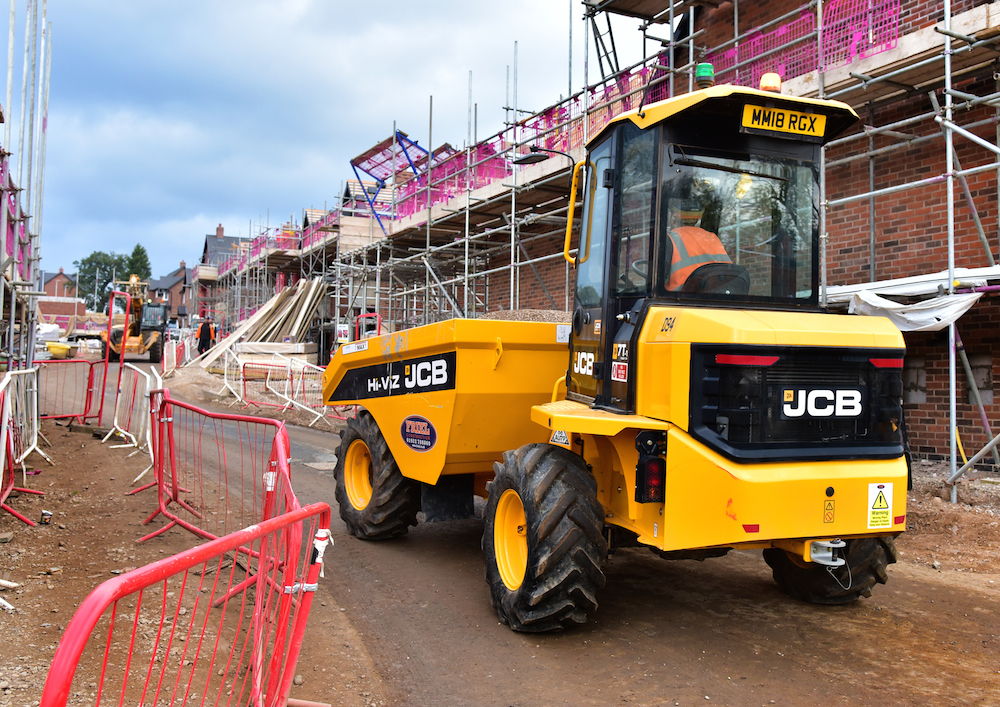
In an added level of protection the driver must be seated and the seat belt engaged before the machine will move forwards or backwards. Moreover, pedestrians are alerted to any initial movement by two automatic beeps of the horn. Similarly, the incidents of slips, trips and falls can be greatly reduced with an operator seated for longer, whilst the powertrain has been configured so that all routine maintenance checks can be completed at ground level.
JCB will shortly be adding to its UK manufacturing bases with a facility dedicated to cabs and it is significant that the design found on its dumpers is entirely bespoke. This is not a drivers’ space that’s been modified from a mini excavator or telehandler but a unit specifically tailored to the demands of a dumper, and its applications.
It’s often only in a factory, where a machine’s components and parts are laid bare, that some of the choices a manufacturer makes can really be appreciated. A higher grade and thickness of steel has been specified at points of stress, for instance. The longevity of the paint finish is improved by a process of shot blasting, followed by the application of two coats of epoxy gloss coat, and during the finishing process the integrity of the hydraulics is ensured with the addition of a UV dye to the system to help identify leaks.
The Hi-Viz concept has found an early champion in JCB’s native Uttoxeter, with Friel Construction, a groundworks firm in the housebuilding sector that’s taken on one of the 7-tonne units. The contractor was already making use of a 10-tonne dumper from a rival manufacturer on a site that will see 150 homes from 2 – 5 beds completed by June of 2019, but has found that the Hi Viz has proven to be more productive. Why? Quite simply because the operator doesn’t have to constantly get in and out of the cab in order to have the skip safely loaded. This end user has equally found the high torque at low revs that the EcoMax engine delivers as useful ally in the often boggy groundworks it undertakes.
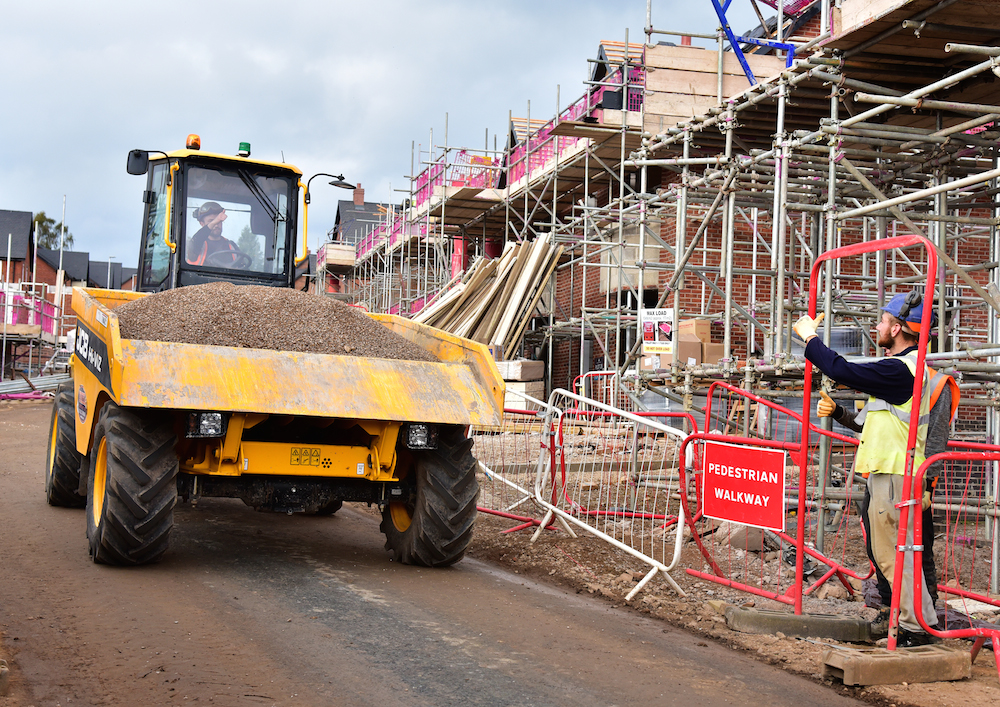
Friel Construction’s Health & Safety Manager, Liam Kenny said: “Health and safety and the protection of our workforce is obviously of critical importance to us and our clients so we chose the JCB 7T-1 HiViz model for the key safety improvements it brings.
“We’ve been impressed by its productivity and it has proved a genuine step forward in terms of visibility. When compared to competitive models, we have seen a significant reduction in the risk of incidents or site damage since introducing the new JCB model. It also gives us great stability and with the reassurance provided by the cab protection it’s a valuable addition to our fleet.”
If site safety is to be improved then working practices must change with the machinery that’s used to undertake them. On many sites, driving up spoil heaps, with the attendant risk of tipping, has been banned, for example. Advances in machinery in parallel can, however, clearly play their part in ensuring that site operatives are not only safe but more productive. As part of the development of its dumper range JCB spent many man hours analysing just how this class of machinery was being used in the industry at large, and where the problems really lay, and has engineered its solution.

